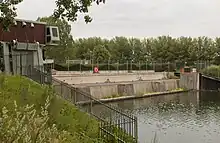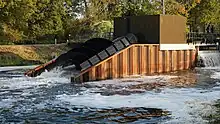
Linne hydroelectric power plant

Dommelstroom hydroelectric power plant
Despite its long interaction with water, the Netherlands has little potential for hydropower due to its flat topography. The Netherlands has a large resource of moving water in its major rivers but its limited hydraulic head because of little elevation change means that hydropower is a minor component of the country's renewable energy portfolio. A few small hydro plants exist but in total produce less than one tenth of one percent (<0.1%) of the Netherlands' electricity.[1]
| Owner |
River | Location | Nominal Power [MW] |
In service |
|---|---|---|---|---|
| NUON | Meuse (Dutch: Maas) | Alphen[2] | 14 | 1990 |
| Essent | Meuse (Dutch: Maas) | Linne[2] | 11 | 1989 |
| NUON | Rhine (Dutch: Rijn) | Amerongen | 10 | 1988 |
| NUON | Lek | Hagestein | 1.8[2] | 1958 |
| NUON | Roer | Roermond[2] | 0.2 | 2000 |
| Essent | Vecht | Gramsbergen[2] | 0.1 | 1988 |
See also
References
- ↑ Hernieuwbare elektriciteit; bruto en netto productie, import en export, Centraal Bureau voor de Statistiek, Den Haag/Heerlen 26-9-2012
- 1 2 3 4 5 "Waterkracht: een energiebron". MilieuCentraal.nl.
This article is issued from Wikipedia. The text is licensed under Creative Commons - Attribution - Sharealike. Additional terms may apply for the media files.